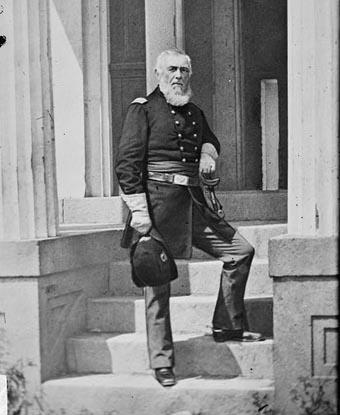Last updated: November 26, 2022
Person
Dixon Stansbury Miles

Library of Congress
From the Peninsula to Maryland: Miles' role in the summer of 1862
Dixon S. Miles graduated from West Point in 1824 and spent the rest of his life serving in the United States military. He saw action in the Seminole War and the Mexican-American War, and by 1859 had achieved the rank of Colonel.
When the Civil War began Miles was stationed at Fort Leavenworth, Kansas. He was brought back to Northern Virginia and put in command of an infantry brigade under Major General Robert Patterson and shortly thereafter promoted to command a division under Brigadier General Irwin McDowell.
At the First Battle of Manassas, General Israel Richardson accused Miles of being intoxicated during the battle. A military court of inquiry initially found this accusation to be true but later cleared Miles of the charges. As a result of the inquiry Miles did not see command again until March of 1862 when he was assigned command of the Railroad Brigade and then reassigned as garrison commander at Harpers Ferry.
At Harpers Ferry, when not faced with floods and attacks by Confederate forces, Miles drilled the soldiers to better prepare them for battle. The next and last battle for Miles occurred September 13-15, 1862 at Harpers Ferry. Confederate troops led by General "Stonewall" Jackson, surrounded the town. Miles, with orders from Major General Wool to "be energetic and active, and defend all places to the last extremity," did not give up hope even when many of the "green" troops retreated from Maryland Heights on the first day of battle.
On the evening of September 13, he instructed cavalrymen to make their way through the Confederate lines and to "try to reach somebody that had ever heard of the United States Army, or any general of the United States Army, or anybody that knew anything about the United States Army, and report the condition of Harper's Ferry." He believed he could defend the place for two days. The next day, Sunday September 14, the Confederates hauled cannons to the mountaintops and Jackson awaited the flag of surrender but his commander on Loudoun Heights, John G. Walker, grew impatient and began firing upon the town about midday. By 7 p.m. that evening, Colonel Miles met with more of the cavalrymen and devised a plan for the remaining 1,400 to escape. Unaware of the departure of the cavalry and now growing impatient that the Federals had not surrendered; Jackson ordered a flanking maneuver during the night, which completely entrapped the Federals.
As cannons resumed firing on the foggy morning of September 15, Miles began to wave the white flag. He was on horseback, calling for the surrender, when an artillery shell exploded behind him and a fragment ripped into his left calf, mortally wounding the garrison commander. Miles was taken back to his headquarters, the master armorer's house in Lower Town Harpers Ferry, where he would die later that day.
